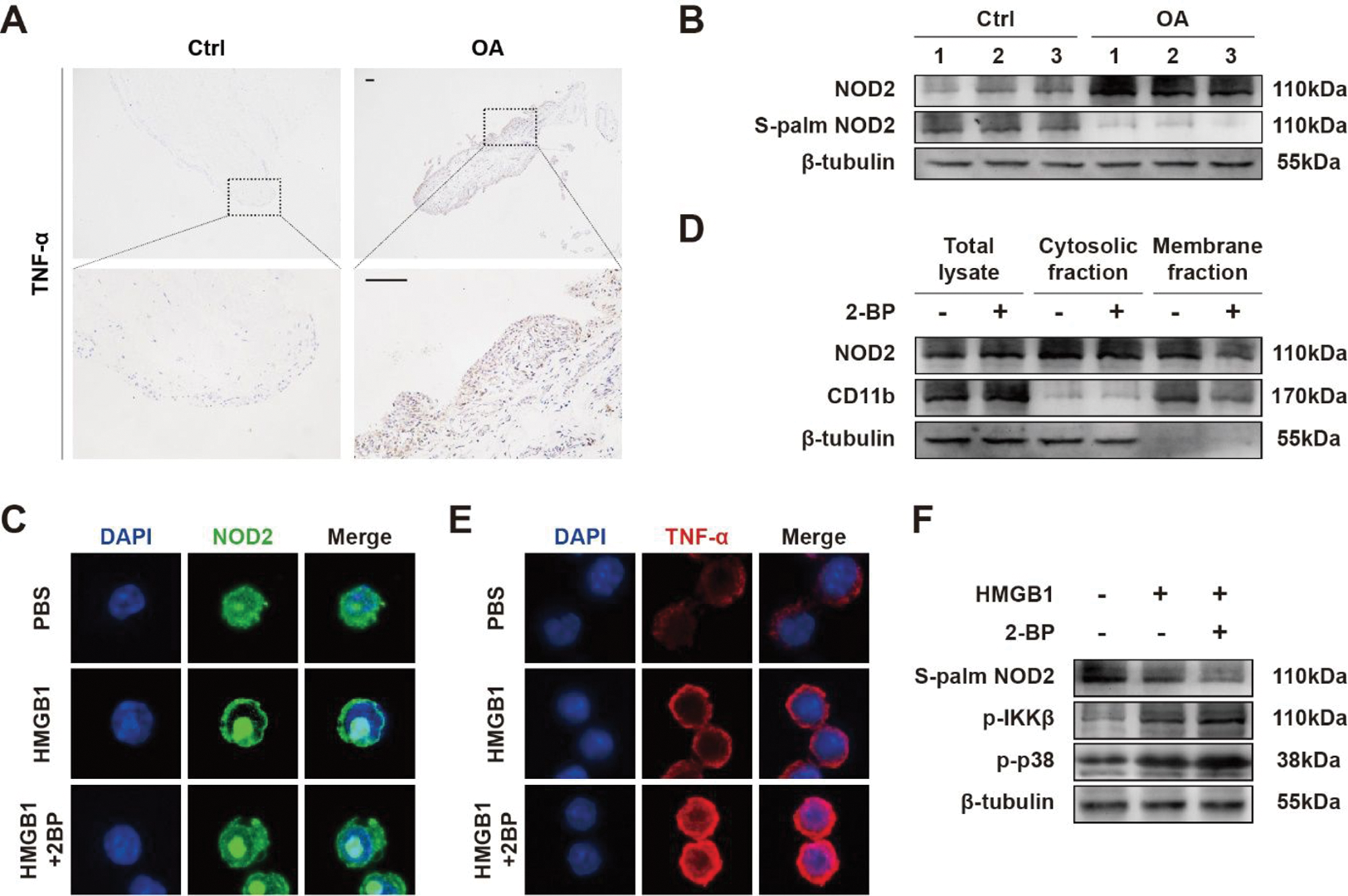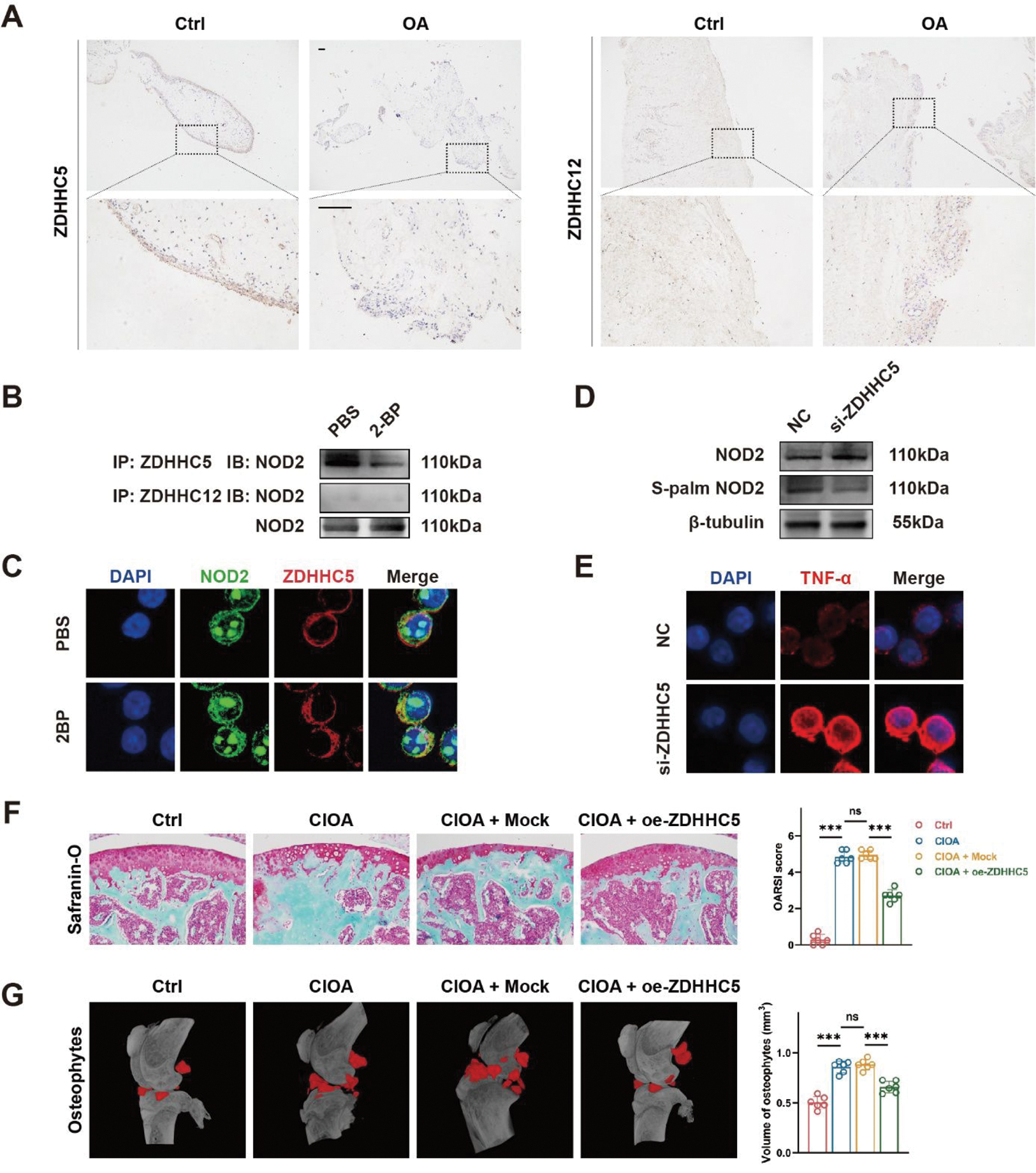

Background: Macrophage activation plays a crucial part in synovial inflammation, a driving force in osteoarthritis (OA) [1]. Our previous research has revealed that NOD2 attenuates OA by modulating macrophage activation, while the underlying mechanism remains unclear. Palmitoylation modification has been demonstrated to be associated with NOD2 activity [2].
Objectives: To demonstrate whether NOD2 palmitoylation contributes to the modulation of macrophage activation and, if so, to uncover the regulatory mechanisms.
Methods: First, we explored the correlation between inflammation and NOD2 palmitoylation in human synovial tissue by immunohistochemical (IHC) staining. Additionally, we investigated the impact of palmitoylation inhibitor (2-BP) on the intracellular localization of NOD2 and the activation of bone marrow derived macrophages (BMDMs). Subsequently, potential targets that may contribute to the palmitoylation of NOD2 were screened via RNA sequencing, followed by co-immunoprecipitation (Co-IP), immunofluorescence (IF) staining, Western blotting (WB), and in vitro inhibition of specific molecule using targeted small interference RNA (si-RNA). Finally, we constructed overexpressing lentiviruses targeting ZDHHC5 (oe-ZDHHC5), established a collagenase-induced OA (CIOA) model with 8-week-old male C57BL/6J mice, and injected lentiviral vectors into the knee joint cavity as the experimental group (CIOA + oe-ZDHHC5), with the empty vectors as the control (CIOA + Mock). 8 weeks later, knee joints were harvested, and Safranin O/Fast Green and 3D reconstruction of Micro-CT images were employed to evaluate the pathological changes of OA.
Results: IHC staining and WB of human synovial tissue indicated a negative correlation between inflammation and NOD2 palmitoylation (Figure 1A and B). Palmitoylation was necessary for the membrane recruitment of NOD2, and was inhibited by 2-BP (Figure 1C and D). Consistent with IHC findings, NOD2 palmitoylation was associated with reduced activation of BMDMs (Figure 1E and F). Bioinformatic analyses suggested two acyl-transferases, ZDHHC5 and ZDHHC12, to be potentially involved in NOD2 palmitoylation. ZDHHC5, down-regulated in osteoarthritis, was involved in the interaction with NOD2 (Figure 2A–C). Targeted inhibition of ZDHHC5 resulted in reduced palmitoylation of NOD2 and increased level of BMDM activation (Figure 2D and E). Finally, in vivo data confirmed that ZDHHC5 overexpression attenuates osteoarthritis in mice, as indicated by Osteoarthritis Research Society International (OARSI) score and osteophyte formation (Figure 2F and G).
Conclusion: ZDHHC5 mediated the palmitoylation modification of NOD2, which was necessary for NOD2 to exert its inhibitory effect on BMDM activation, thereby attenuating OA.
REFERENCES: [1] Zhang H, Lin C, Zeng C, Wang Z, Wang H, Lu J, et al. Synovial macrophage M1 polarisation exacerbates experimental osteoarthritis partially through R-spondin-2. Annals of the rheumatic diseases. 2018;77(10):1524-34.
[2] Lu Y, Zheng Y, Coyaud E, Zhang C, Selvabaskaran A, Yu Y, et al. Palmitoylation of NOD1 and NOD2 is required for bacterial sensing. Science. 2019;366(6464):460-7.
NOD2 palmitoylation is associated with reduced synovial inflammation. (A) More significant synovial inflammation in OA compared with Control group (Scale bar = 100 μm). (B) Higher level of palmitoylated NOD2 in synovial tissue of Control compared with OA. (C-D) 2-BP inhibited palmitoylation-drived membrane recruitment of NOD2. (E-F) NOD2 palmitoylation is associated with reduced activation of BMDMs

ZDHHC5 mediates the palmitoylation modification of NOD2 and attenuates OA in mice. (A) ZDHHC5 was down-regulated in OA synovium, but not ZDHHC12 (Scale bar = 100 μm). (B) Interaction between NOD2 and ZDHHC5 was shown, but not with ZDHHC12. (C) ZDHHC5 colocalized with NOD2 in BMDMs. (D) ZDHHC5 inhibition reduces palmitoylation level of NOD2. (E) ZDHHC5 inhibition promotes BMDM activation. (F) Safranin O/Fast Green staining and OARSI score of mouse knee joints (n=6 for each group). (G) Micro-CT and osteophyte formation of mouse knee joints (n=6 for each group)

Acknowledgements: I would like to thanks all people who have helped and were directly or indirectly involved in this study. This work was supported by Guangdong Medical Research Foundation [A2020094], Guangdong Basic and Applied Basic Research Foundation [2021A1515110996, 2023A1515010463], and Science and Technology Project of Guangzhou [202102020132, 202206010140].
Disclosure of Interests: None declared.